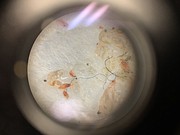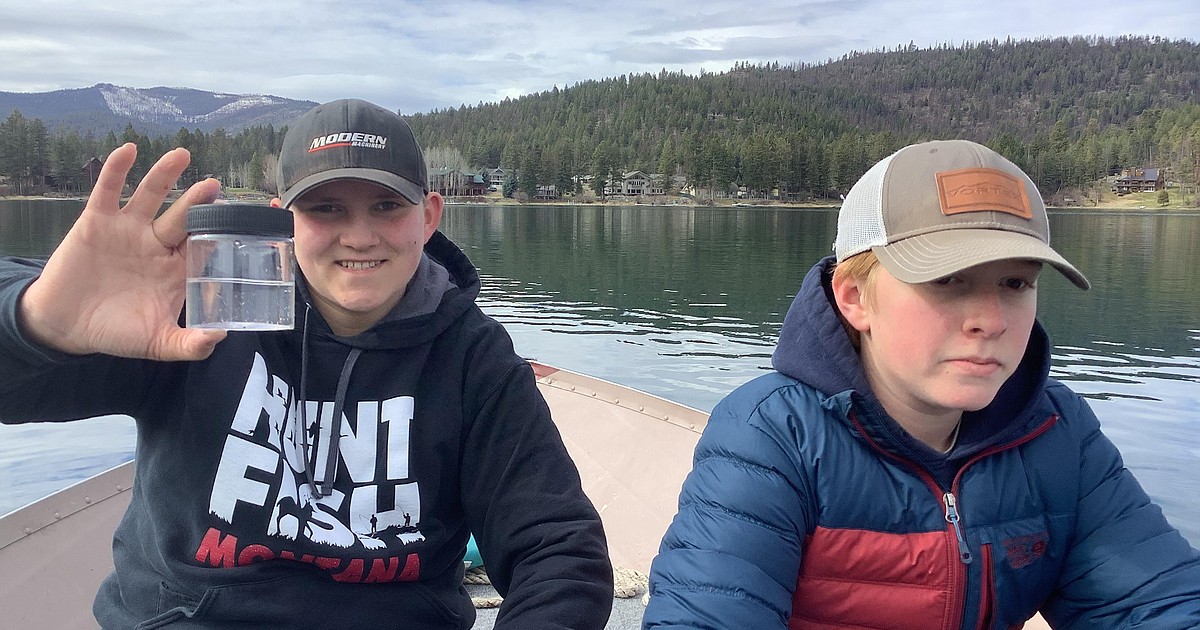The Kalispell Middle School Science Club recently won a statewide award for their work regarding microplastics in local lakes.
The club, made up of students in grades six through eight, won the Montana Department of Environmental Quality’s Saving Money and Resources Today (SMART) schools challenge and received $2,000.
Science Club Councilor Annie Gustafson said this is the first time Kalispell Middle School has taken part in the SMART Schools Challenge.
The club’s main projects included research and community education on microplastics in local lakes and on native plants. Club members also organized a native plant garden at the school and held a community “Trash Bash” cleanup for Earth Day.
Eighth grade students Rita Henshaw, Dylan Bauer and Sam Syverson teamed up and chose to conduct the microplastics study at Foys Lake. What piqued their interest was an October 2021 Hungry Horse News article that reported that Glacier National Park fisheries biologist Chris Downs had found microplastics in Lake McDonald.
The National Oceanic and Atmospheric Administration defines microplastics as “small pieces of plastic less than 5 millimeters in length,” which can be harmful to aquatic life.
The students contacted Downs to walk them through the same procedures and protocols he used to collect and test water samples from Lake McDonald. The group chose Foys Lake for its proximity to the college and because it is a popular destination in the valley for fishing, boating, swimming and water skiing. The location also has a residential development.
“There’s also a lot of winter activity for fishing,” Syverson said.
The group was convinced that they would find microplastics.
“Our attitude was like if we find microplastic, that would be very good for our study but very bad for the environment,” Henshaw said.
“I was expecting a lot of plastic because I just know a lot of people go there,” Bauer added.
THE GROUP started the project by superimposing a grid on a map of Lac de Foys. Henshaw said they used a random number generator to decide which points on the lake they would sample. The group said they sampled 11 different points, covering around 20% of their grid.
Then they lowered a plankton net (a very fine mesh net) into the water.
“It lets water through, but it still catches zooplankton,” Bauer said, describing the mesh size. “We only had a 25ft rope so we descended about 20ft. Some of the deepest points are just over 100 feet.
After the water samples were passed through coffee filters, they were ready to go under the microscope. The students used Downs’ hot pinning technique to determine if what they were looking at under the microscope was plastic or not. This meant heating pins over a flame, then poking what they suspected was plastic. If it rolled up, it was documented as a microplastic.
“There was a really bright pink one that we found early on,” Bauer said.
“It looked like a little pink square,” Syverson said.
Other samples weren’t as obvious.
“There were probably an average of five microplastics in each sample,” Siverson said.
The group was asked if what they found was a little or a lot for a lake of this size, Gustafson reminded them to try not to quantify at this stage.
“We don’t have a baseline of what an average lake would have in terms of plastic because it’s not normally in a lake,” Bauer said. “Really, any plastic in the lake is a lot because it’s foreign material. I think they classify it as urban debris.
Concerned about harmful plastics entering the food chain, the group was curious if they could find microplastics in the digestive systems of fish caught during the winter break and frozen.
“We thought it would be a fun experience while waiting for Foys to thaw out,” Gustafson said.
As with many experiments, there are successes and failures. The dissection was messy.
“There were 16 minnows in there,” Syverson said. “We also found a small pine cone and some sunflower seeds, which weren’t put in by nature.”
The group would like to continue their research, either continuing to sample Lake Foys or testing Lake Bitterroot.
A global takeaway came from the project.
“We need to do more to prevent this,” Henshaw said, which means educating the public.
The group then traveled to the State Capitol in Helena to present at the SMART Schools Symposium where Governor Greg Gianforte stopped to take a look at a piece of microplastic under a microscope.
The group also presented their findings to the school’s board of trustees in hopes that a district-wide “green team” could be assembled. The team would be made up of student and staff representatives.
“This team would focus on reducing single-use plastic from our schools and work on reducing waste and saving energy,” Henshaw said. “The green team would be made up of students and teachers representative of each school. This group would work with the community and the school board to reduce and save energy.
Reporter Hilary Matheson can be reached at 406-758-4431 or by email at [email protected].
Reporter Hilary Matheson can be reached at 406-758-4431 or by email at [email protected].



